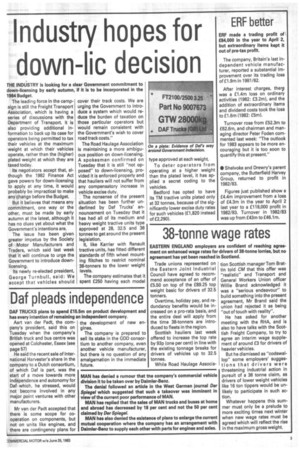Industry hopes for down-lic decision
Page 5

If you've noticed an error in this article please click here to report it so we can fix it.
THE INDUSTRY is looking for a cl down-licensing by early autumn, 1984 Budget.
The leading force in the campaign is still the Freight Transport Association, which is having a series of discussions with the Department of Transport. It is also providing additional information to back up its case for operators being permitted to tax their vehicles at the maximum weight at which their vehicles operate, rather than the (higher) plated weight at which they are taxed today.
Its negotiators accept that, although the 1982 Finance Act gave powers for down-licensing to apply at any time, it would probably be impractical to make any change before the Budget.
But it believes that means any commitment, one way or the other, must be made by early autumn at the latest, although it has no clues yet about what the Government's intentions are.
The issue has been given greater impetus by the Society of Motor Manufacturers and Traders, which said last week that it will continue to urge the Government to introduce downlicensing.
Its newly re-elected president, George Turnbull, said: We accept that vehicles should cover their track costs. We are urging the Government to introduce a system which would reduce the burden of taxation on those particular operators but would remain consistent with the Government's wish to cover road track costs."
The Road Haulage Association is maintaining a more ambiguous position on down-licensing. A spokesman confirmed on Tuesday that it is still "not opposed" to down-licensing, provided it is enforced properly and that hauliers will not suffer from any compensatory increase in vehicle excise duty.
The nonsense of the present situation has been further underlined by Daf Trucks' announcement on Tuesday that it has had all of its medium and heavy weight tractive units type approved at 28, 32.5 and 38 tonnes to get around the present legislation.
It, like Karrier with Renault tractive units, has fitted different standards of fifth wheel mounting flitches to restrict nominal 38-tonners to the lower weight levels.
The company estimates that it spent £250 having each model type approved at each weight.
To deter operators from operating at a higher weight than the plated level, it has applied a secret coding to the vehicles.
Bedford has opted to have its TM tractive units plated only at 32 tonnes, because of the significantly lower excise duty rates for such vehicles (£1,820 instead of £2,290).








































































































